- More More
- Blog
- Inspire me
- Groups
- Offers More
- Dive Courses More
- Liveaboards
More

Liveaboard Trips
On-board accommodation offering the opportunity to live right over the dive sites and to experience secluded dives...
Diving regions...
- LATEST AVAILABILITY BY REGION
- Red Sea availability
- Maldives availability
- Indonesian availability
- Socorro Mexico availability
- Galapagos availability
- ALL LIVEABOARD DIVING REGIONS
- Bahamas
- Bikini Atoll
- Caribbean
- Cocos Island
- Destinations
MoreDIVING REGIONS...
Our Top destinations....Why not try....
Find a trip
- Resort
- Liveaboard
Trip Report: Raja Ampat, Indonesia
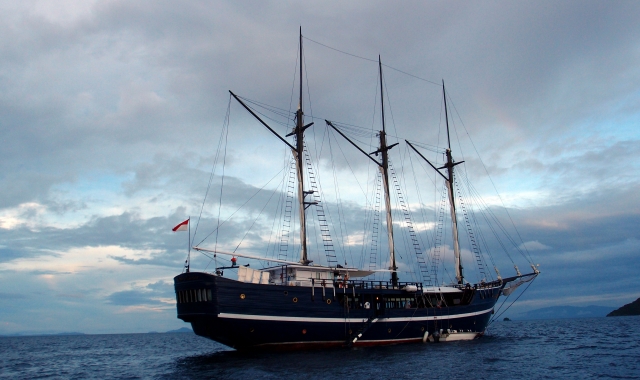
14 Oct 2013, Jane H
Regaldive Team Member John has just returned from a ‘trip of a lifetime’ to Raja Ampat, Indonesia. John’s itinerary aboard the exceptional Dewi Nusantara took in the very best diving of this region. Read his trip report:
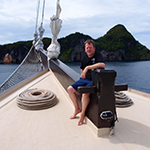 Wow, what a trip! It’s been described by others as the trip of a lifetime, but the trouble is I want to do it far more than just once in my lifetime!
Wow, what a trip! It’s been described by others as the trip of a lifetime, but the trouble is I want to do it far more than just once in my lifetime!
Of course it takes a while to get to the other side of the world, but it is so worth it. The first part, which for me was a Singapore Airlines A380 to Singapore was actually a lot easier than I thought it would be. A comfortable plane with reasonable leg-room, good entertainment and good service made the 12 and a half hours very bearable. The internal flight was a bit more like travelling with a UK budget carrier, but that was only for the last bit of the journey.
When I got to Sorong in West Papua (formally Irian Jaya) I joined a fantastic liveaboard called Dewi Nusa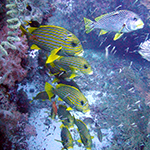 ntara. Really an amazing boat. It looks pretty stunning as it’s built along the lines of a mid 1800’s 3 masted schooner, so it’s not like your normal dive boat. The wow factor of the boat doesn’t stop there, it’s amazing inside too, with wood everywhere and handmade bespoke wooden furniture. There’s plenty of room on the dive deck, saloon and bedrooms, so with only 18 guests on board you can always find a bit of space. Photographers are well looked after too, with their own camera room.
ntara. Really an amazing boat. It looks pretty stunning as it’s built along the lines of a mid 1800’s 3 masted schooner, so it’s not like your normal dive boat. The wow factor of the boat doesn’t stop there, it’s amazing inside too, with wood everywhere and handmade bespoke wooden furniture. There’s plenty of room on the dive deck, saloon and bedrooms, so with only 18 guests on board you can always find a bit of space. Photographers are well looked after too, with their own camera room.
Another thing that makes the boat so special is the crew and the organisation on board. They are all so friendly and had an amazing ability to remember everyone’s names, almost from day one. Diving is made very easy as all your kit is labelled and was always in exactly the right place when you needed it. Even your camera was taken to the dive tender and handed to you just before, or after, you rolled into the water.
So 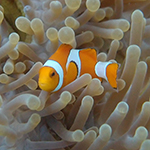 the boat and the crew were great, but what about the diving? It’s definitely got to be considered some of the best in the world. Raja Ampat is at the heart of the Coral Triangle of South East Asia so was never going to disappoint. But what strikes you is the sheer amount of pristine hard and soft corals, and the number of fish, especially on the reefs around the south of Waigeo Island and the north of Batanta. The reef at Cape Kri is officially recognised as having more species than any other dive site in the world. Needless to say I didn’t try and prove the scientists wrong and just enjoyed the dive.
the boat and the crew were great, but what about the diving? It’s definitely got to be considered some of the best in the world. Raja Ampat is at the heart of the Coral Triangle of South East Asia so was never going to disappoint. But what strikes you is the sheer amount of pristine hard and soft corals, and the number of fish, especially on the reefs around the south of Waigeo Island and the north of Batanta. The reef at Cape Kri is officially recognised as having more species than any other dive site in the world. Needless to say I didn’t try and prove the scientists wrong and just enjoyed the dive.
To the north of Raja Ampat the reefs are slightly different, not so much large coral and big schools of fish, but more looking for little stuff. The islands of the Equator group are very much for the diver looking for the little things, certainly a macro photographer's heaven. I never thought I would get too excited finding Nudibranchs, but a new camera with a good macro setting certainly helps. A decent picture of a Pygmy Seahorse failed me though. 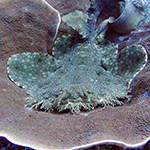
As we moved back south we came to a dive site called Eagle Rocks, named after the many Sea Eagles nesting in the trees. We did two dives there and were lucky enough to see Manta Rays on both dives. Really pleasing as later in the week you might guess that a dive site with ‘Manta’ in it’s name yielded us none at all. Just the luck of the draw I suppose.
The highlights underwater for me where probably the good number of Tassled Wobbegong Sharks we saw, at least a dozen or so during ten days diving. Also the Raja Epaulette sharks that we saw on most of the night dives. Both of these species are great for photographers as they don’t move much and if they do it’s rather slow. Not like those fish that you just get lined up for a shot and they turn their back or nip behind the nearest bit of coral. Lots of fast moving Blacktip Reef Sharks and a few Whitetips too. 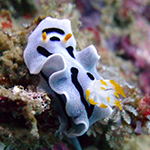 A good dive guide is essential though and I’m please to say we had some of the best. It’s amazing how they can swim straight up to a fan coral and find a Pygmy Seahorse in seconds. The little critters are only a few millimetres long and difficult enough to see, let alone photograph, even when being pointed out to you.
A good dive guide is essential though and I’m please to say we had some of the best. It’s amazing how they can swim straight up to a fan coral and find a Pygmy Seahorse in seconds. The little critters are only a few millimetres long and difficult enough to see, let alone photograph, even when being pointed out to you.
So we saw the tiniest of Seahorses, up to the biggest of Mantas and everything in between. Other highlights were the big shoals of schooling fish, Bumphead Parrotfish and a couple of Banded Sea Snakes. The night dives yielded quite a few different types of Squid, Cuttlefish and Octopus, including the famous Blue Ringed variety. The biodiversity of the reefs means that there is something for everyone in Raja Ampat. The area is totally unspoilt, both above and below the water and we didn’t see another dive boat until the very last of our 38 dives. 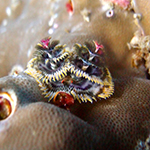
A wonderful trip that’s just got to be on any divers ‘must do’ list. Just hope I get the chance to go back there one day!
Thanks to John for these great photos of his trip!






